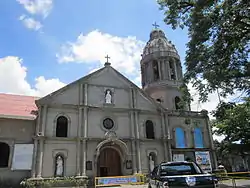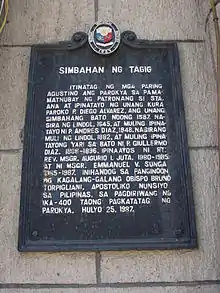Taguig Church
The Saint Anne Parish Church, also known as Santa Ana Church or also known in its formal name as the Archdiocesan Shrine of St. Anne, is a Catholic church located at Barangay Santa Ana, Taguig. It is situated next to the Taguig River and across Plaza Quezon, where the statue of the late Manuel L. Quezon was erected when he was still serving as President of the Philippines.[1] Saint Anne is the patroness of the church.
| Saint Anne Parish Church, Taguig | |
|---|---|
| Archdiocesan Shrine of St. Anne | |
| Taguig Church | |
Simbahan ng Tagig | |
 | |

| |
| 14.526944°N 121.073889°E | |
| Location | 41 Liwayway Street, Santa Ana, Taguig |
| Country | Philippines |
| Denomination | Roman Catholic |
| History | |
| Founded | 1587 |
| Founder(s) | Fr. Diego Alvarez, OSA |
| Architecture | |
| Functional status | Active |
| Heritage designation | Cultural Property |
| Designated | July 25, 1987 |
| Architectural type | Baroque |
| Administration | |
| Parish | Saint Anne Parish Church |
| Diocese | Roman Catholic Diocese of Pasig |
History
Building of the church

In 1571, the Spaniards subjugated mainland Luzon including Taguig through the Legazpi expedition. Between the years 1582 and 1583, Taguig became part of the Encomienda del Tondo and was under the headship of an Alcalde Mayor, Captain Vergara.[2] Taguig was eventually established as a separate town in 1587 and was declared a parish with St. Anne as its chosen patroness. Augustinian friars, Fr. Diego Alvarez and his assistant, Fr. Diego de Avila, were assigned to begin religious activities in Taguig.[3]

The first concrete church for use of the faithful was built by Fray Hernando Guerrero, O.S.A. in 1609. However the 1645 Luzon earthquake caused it considerable damage. In 1848, Fray Andres Diaz, O.S.A. began the construction of a new church complex. This too, unfortunately was destroyed by the tremor of 1882. To continue administering to the spiritual needs of the faithful, a makeshift church was used until the construction of a permanent one.
Construction of the present church started during the term of Fray Patricio Martin, O.S.A. in 1883. He however did not see its completion due to his early demise. His successor, Fray Guillermo Diaz, O.S.A. continued with the project and saw its eventual completion.[3]
During the early American Period, secular priest of the Archdiocese of Manila succeeded the Augustinian Friars in Taguig. The first of these was Father Silbino Labao of Tipas. He was followed by Fr. Vicente Estacio of Tipas who oversaw the installation of the church's sawali ceiling. Fr. Gerardo Maximo completed the rehabilitation of the church. More improvements in the edifice were undertaken by Msgr. Augurio Juta and Msgr. Emmanuel Sunga in preparation for the parish's 400th anniversary in 1987.
Japanese Occupation of Rizal
In 1942, Imperial Japanese invaded the Province of Rizal and established garrisons in the town. The church was remembered as the place where hundreds of male inhabitants were incarcerated for a number of days in August 1943.[4]
Present
The current parish priest of Saint Anne Parish Church is Rev. Fr. Renier Noel N. Llorca. The church houses the Museo de Sta. Ana, which contains religious relics and repository of artifacts detailing the rich religious culture and history of Taguig since 1857.[5] On July 26 of each year, the church along with the City Government, celebrates Sta. Anang Banak Taguig River Festival which is a fluvial parade in honor of the town patroness. The thrills and excitement of the fishers are replayed each year by the pasubo where fluvial parade participants in colorful boats and spectators by the riverbanks toss fruits and native delicacies to each other.[6]
Aside from the July festivities, which is also the Liturgical Feast of Sts. Joachim and Anne, the Pistang Pasasalamat (Thanksgiving Feast), locally known as Pistang Bayan ng Taguig (Taguig Town Fiesta) is celebrated every Quinquagesima, the Sunday preceding Ash Wednesday. It is a celebration of thanksgiving to St. Anne, especially for her intercession paved the way to the liberation of Taguig from the hands of the Japanese forces during the Second World War.
Architecture
According to Architect Manuel Maximo Lopez Del Castillo Noche, a member of the International Council on Monuments and Sites (ICOMOS), the structure of the church follows the barn-style Baroque architecture design "with its very defined articulation of both vertical and horizontal bays topped by a simple triangular pediment."
Cemetery
Among the notable features of the church complex of Santa Ana in Taguig is the old funerary chapel. Constructed in the 1700s using Filipino forced labor, the chapel is made up of tiles and walls of stones. It measures 12 meters in diameter with its ground level reserved as repository for bones. Despite minor repairs in 1980 and in 1993, the Simborio, as it is called, stands beautiful yet quaint in the old cemetery of the parish.
Declaration as a Historic Site and Cultural Property

On July 25, 1987, the National Historical Commission of the Philippines installed a marker on Saint Anne Parish Church for its historical value and patriotic endeavors to dramatize the need to focus to the national consciousness the history of the country from the Filipino viewpoint and to evoke pride in the national heritage and identity.[7][8] The church was also declared and recognized by the government as a cultural property based on the official list provided by the National Commission for Culture and the Arts, National Historical Commission of the Philippines and the National Museum of the Philippines.
References
- "Plaza Quezon". Archived from the original on 2013-10-12. Retrieved 2014-06-03.
- "History of Taguig".
- Espenilla, Roberto; Denoga, Estela P. (January 2004). Shrines: Incarnating Christ Today (2, illustrated ed.). ISBN 9715049818.
- The Division Organizing and Coordinating Committee, Division of Rizal (June 1964). "The History of the Province of Rizal". Cite journal requires
|journal=(help) - "Museo De Sta. Ana". Archived from the original on 2014-06-06. Retrieved 2014-06-03.
- "Sta. Anang Banak Festival".
- (PDF) http://nhcp.gov.ph/wp-content/uploads/2012/10/List-of-Sites-Structures-with-Markers-as-of-Jan-16-2012.pdf. Missing or empty
|title=(help) - https://web.archive.org/web/20140606210138/http://nhcp.gov.ph/installation-of-historical-markers-2/. Archived from the original on 2014-06-06. Missing or empty
|title=(help)
| Wikimedia Commons has media related to Taguig Church. |